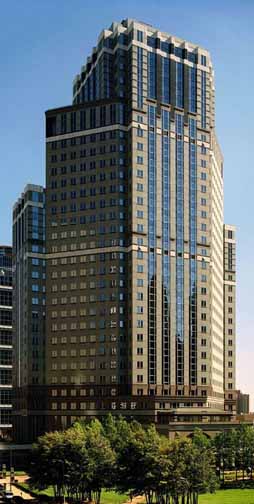Pla-Mor Ballroom
724 Fourth Ave. So.
Minneapolis
This is the story of the building at 724 Fourth Ave. So. in Minneapolis.
THE VENUES
This building had a dizzying array of entertainment venues over its 75 year life; this may not even be a complete list:
- Eagles Hall
- Pla-Mor Ballroom
- CIO Hall
- FDR Memorial Hall
- Diamond Lil’s
- Times Square
- Friar’s Dinner Theater
- Friar’s Minnesota Music Hall Dinner Theater
- Chimera West
- Betty Jo Byoloski’s
- Off Night Music Hall at the Downtown Dinner Theater
- Central Park
- Down Under at the Haymarket
- Herald’s Christian Supper Club
- Music Box
- Discotrec II
- Little Al’s
- Dave Rooney Lounge
- Friar’s Cabaret
- Music Preserve
THE BUILDING
Minneapolis permit cards for 718-28 4th Ave. So. indicate that a brick office building was built at this location in 1906. (A tenement building was also on the property in 1904, but it was razed in 1919.) Several additions were made, and the final footprint was 82 ft. by 134 ft. by 24 ft.
The building had two stories and a basement, which makes tracking the different venues in it somewhat difficult. I’m aware that some of the venues below overlap. Presumably the second story was an open hall, based on uses noted on the permit cards.
The first use of the building shown is a shoe shop in 1915, probably on the first floor.
EAGLES HALL
In 1925 it was a lodge or “Community Club Building.” This may have been the period when the building served as the home of Eagles Aerie No. 34. The photo below is from 1950, but you can see Aerie No. 34 etched above the door. Aerie No. 34 still exists and hosts dances on a regular basis in another location.
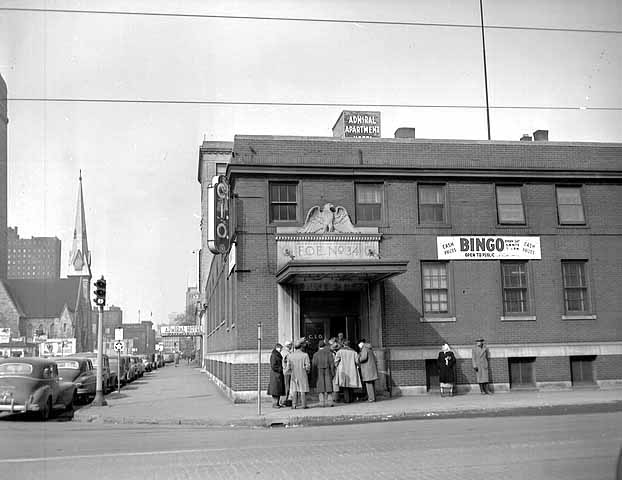
In 1941, Aerie No. 34 moved to the second floor of the Transportation Annex Building, 4th Street and 2nd Ave. So. The space was leased and the Eagles spent $10,000 remodeling it for their use.
PLA-MOR BALLROOM
In 1933 the building was listed on the city’s permit cards as a dance hall. The first mention of the Pla-Mor Ballroom shows up in the Minneapolis papers on October 12, 1934. In the 1930s it was the site of Barn Dances hosted by Thorstein Skarning.
There were other Pla-Mor Ballrooms around the State, including:
- The Pla-Mor Ballroom at 1904 E. 9th St. in Glencoe, owned by Raymond T. Olson. It is the only one remaining.
- Pla-Mor Ballroom on Highway 7 in Silver Lake. Advertised in Minneapolis papers until 1956. That year the Pla-Mor in Silver Lake was owned by Mr. and Mrs. Harry Dostal, who appealed the provision in the Dance Hall act that prohibited the sale of 3.2 beer – they won in June in 1956.
- The Pla-Mor Ballroom at 2045 14 Hwy E in Rochester. Jerry Lenz of the Nickel Revolution found this notice of its demise in December 2006: “The Pla-Mor Ballroom, where Rochester area couples danced to live bands for more than half a century, now has disappeared into a pile of rubble and into city history. The 55-year-old building would have been too costly to restore.” It had been put up for sale in 1973.
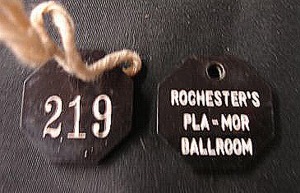
- There was a Playmor Ballroom in Pipestone – a misspelling or another franchise?
- Pla-Mor Roller Rink is at 1422 E US Highway 169 in Grand Rapids.
The last mention of the Minneapolis Pla-Mor shows up in 1946.
CIO HALL
On October 29, 1943, the “old Eagles Hall” was purchased by CIO (Congress of Industrial Organizations) Locals 1139, 1140, 1145, and 1146 of the United Electrical, Radio, and Machine Workers Union of America. The building was purchased to house state CIO headquarters and headquarters of other CIO unions which had been located at 1126 Harmon Place. There were 10 office, a main hall seating 1,500 people, seven smaller halls seating up to 400 people each, and kitchens. Howard Fortier was chairman of the CIO Hall committee in charge of the building.
Grand opening of the building was scheduled for October 30, 1943. Nine vaudeville acts and dancing were scheduled as entertainment at the grand opening.
During its CIO Hall days the building was mostly used for political and union meetings, but there were also some concerts and dances held here.
In 1944 you could dance to Bud Strawn’s Orchestra every Saturday night, and if you were in the service you could get in free of charge. Dances were held there until at least 1952. In 1955 it was still listed as a “labor hall” on its permit card.
Lucky Millinder and his band appeared at the Hall on July 28, 1946.
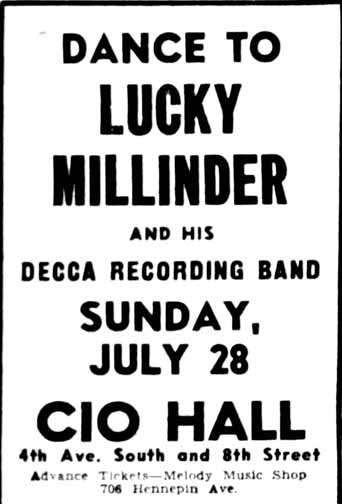
This ad appeared for the Ernie Bjorklund band, which appeared at the CIO Hall every Sunday Night in 1947.
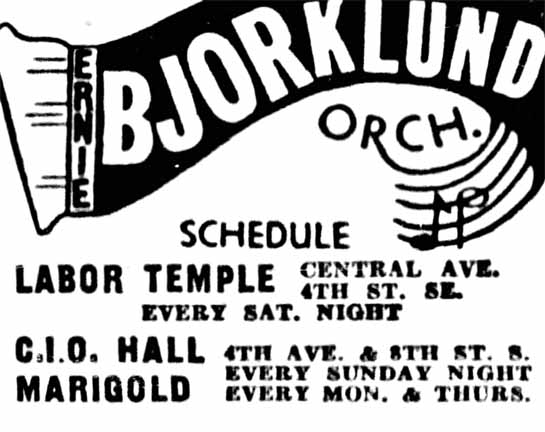
Earl Bostic and his Orchestra appeared for a Thanksgiving dance on November 25, 1950.
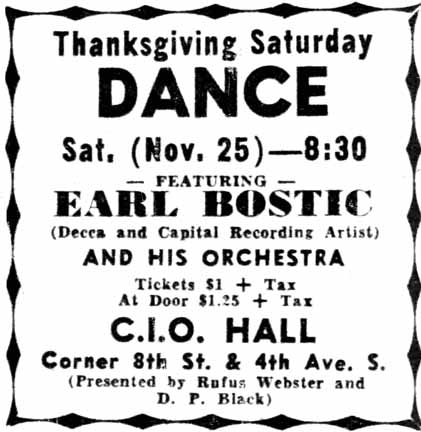
FDR MEMORIAL HALL
The building was referred to as the FDR Memorial Hall in an article dated August 31, 1958 in the Minneapolis Tribune. There were other entries before that for a Memorial Hall, but no address was given.
Will Jones described it as a labor union meeting place.
In 1966 the building was sold. At this point we will have to divide the building into Upstairs and Downstairs, as they had different venues at different times.
UPSTAIRS
DIAMOND LIL’S
In July 1966 the upstairs was transformed into Diamond Lil’s, a nightclub with a Gay ’90s motif. Diamond Lil’s was originally a private or “Key Club.”
(In March 1966 there was a different Diamond Lil’s Bar at 3607 Washington Ave. N. This one eventually succumbed to a fire.)
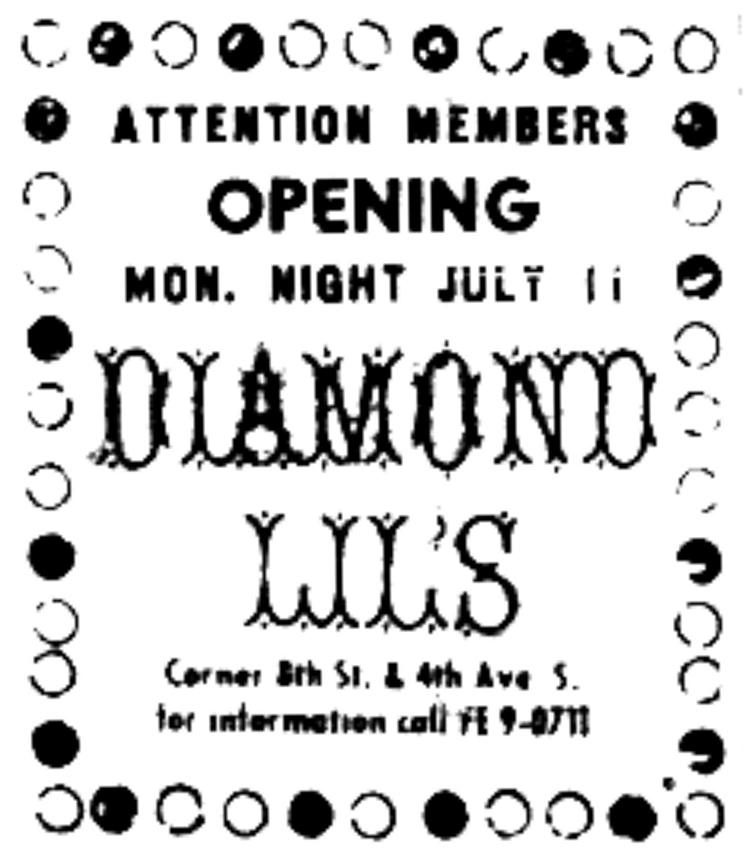
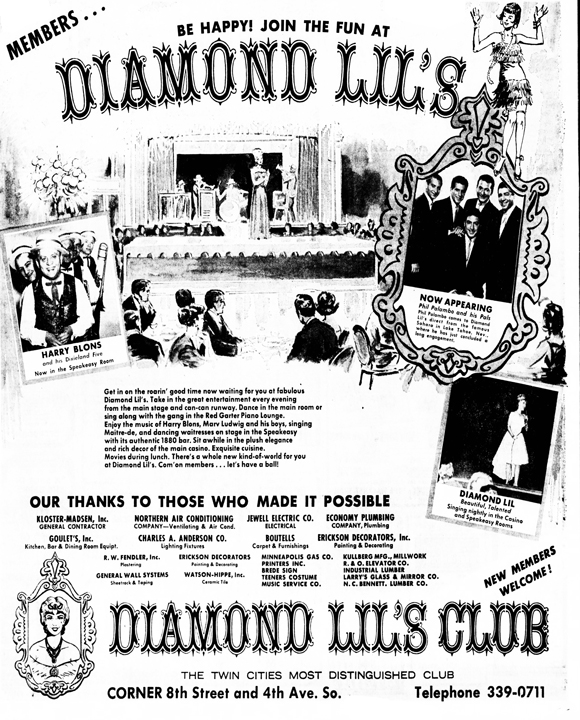
Diamond Lil’s brought in name acts that appealed to an older set (Helen Forrest, Bob Eberle, Julius LaRosa), and brought in a revue that featured a couple of topless showgirls.
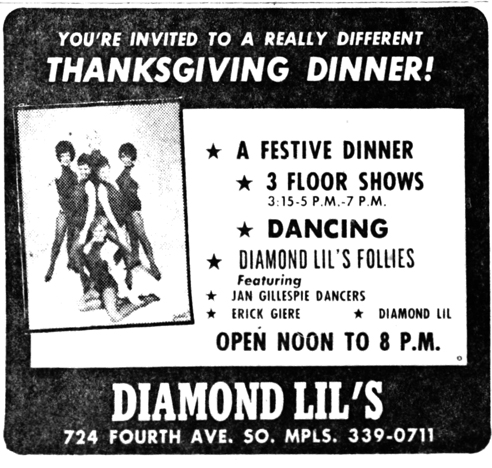

By October 1967, Diamond Lil’s was “Open to Everyone!”
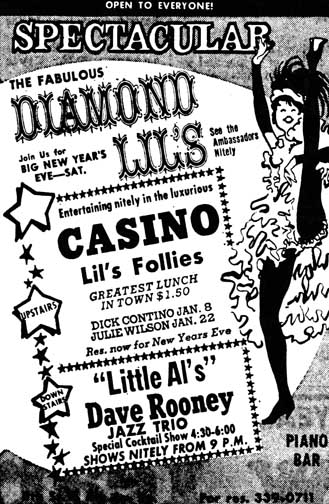
Gregory LaLonde says that the band The Blue Fox played there on election night, November 1968 and that it was “quite a place.”
In about August 1969, prominent businessman Jack Dow purchased the building “as a hedge against losses” from the Hotel Hastings, which he also owned. His plan to make money on Diamond Lil’s to make up for losses on the hotel didn’t exactly work, though – little did he know that the building was cursed.
Dave Rooney was a regular at Diamond Lil’s, and recorded an album there, appropriately called “Live at Diamond Lil’s.”
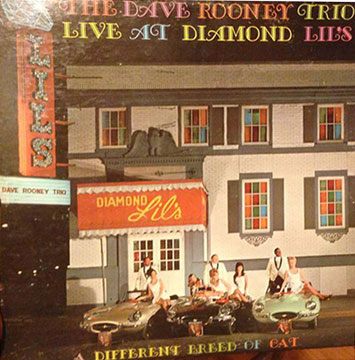
I love this fantasy album cover, with the Trio showing off their cars and groovy chicks. Here’s a closeup:
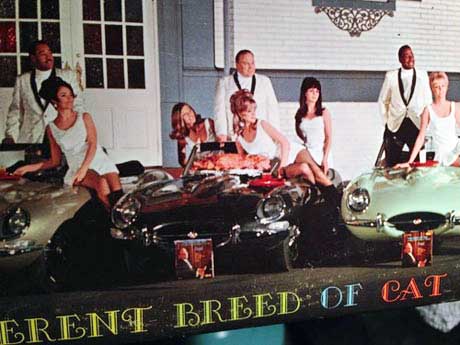
TIMES SQUARE
It became clear that the Diamond Lil’s concept wasn’t bringing in the crowds, and it was time to do something else. Owner Jack Dow made an agreement with Danny Stevens, leader of Danny’s Reasons, to let Danny run the entertainment. The new rock club was renamed Times Square, and it opened on October 3, 1969. Bands on hand were Soulsberry Jam, Zarathustra, Cisco Grove, and Danny’s Reasons.
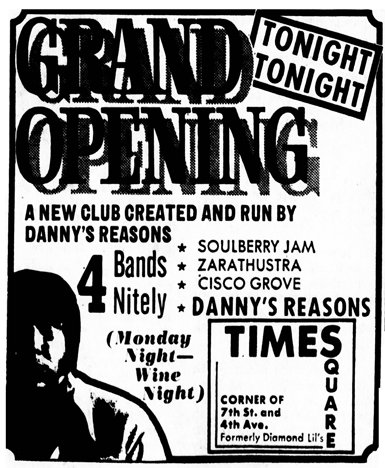
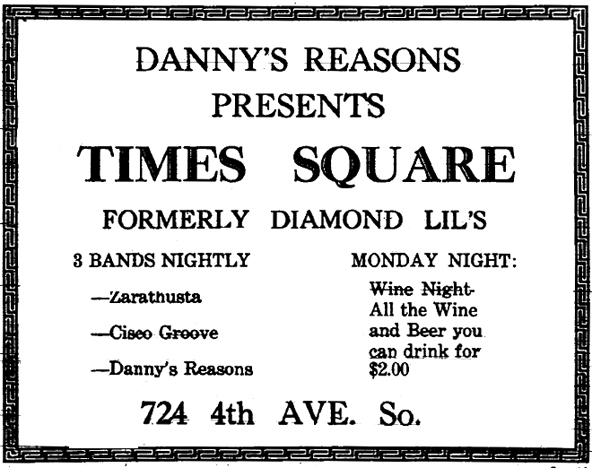
From the first, the club featured Monday Wine nights, where patrons could buy a cup for a certain price and get as many refills as they wanted. Danny said that the wine was Bali Hai, and the night was especially popular with college professors!
Jeanne Ray with the Village Knights provided music for dancing in 1969.
Ads in the Minneapolis papers indicated that entertainment was provided by mostly local bands. Danny said that national musicians would come over after their shows at bigger venues and jam into the night here.
THE NICE
One national band that performed at Times Square was The Nice, featuring Keith Emerson. An email inquiry from Karl Speck wanted to track down the exact date of this performance, because it was not mentioned in the Minneapolis papers. Danny remembered,
I think it was the Wednesday night before Thanksgiving or Thanksgiving night. I also remember it was one of their last shows before becoming Emerson, Lake, and Palmer. They were brought in by Timothy D. Kehr and he got free radio advertisement for the show.
Another website confirms that The Nice were at Times Square on November 26, 1969, the day before Thanksgiving. The Nice played its last show on March 31, 1970, before regrouping into Emerson, Lake & Palmer. Thank you to Karl and Danny for their remembrances, 54 years later!
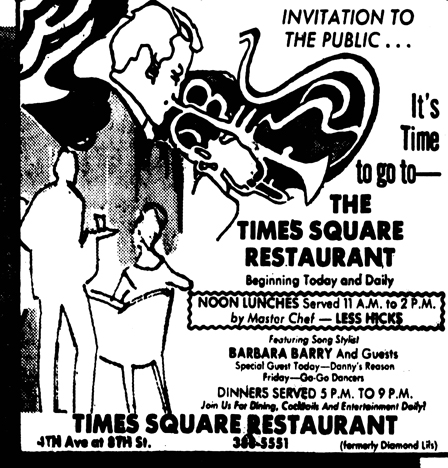
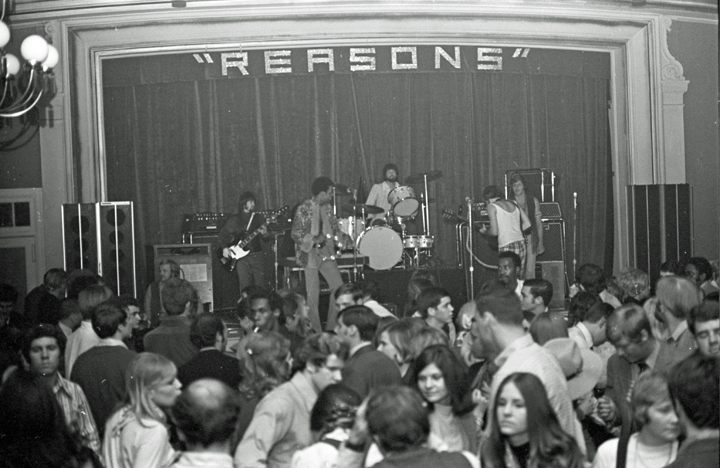
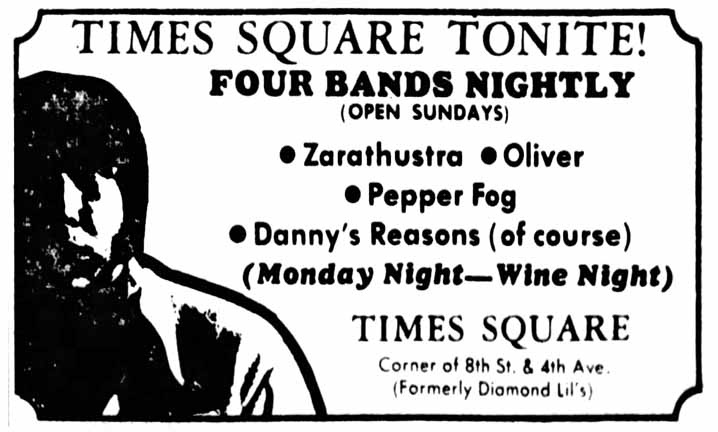
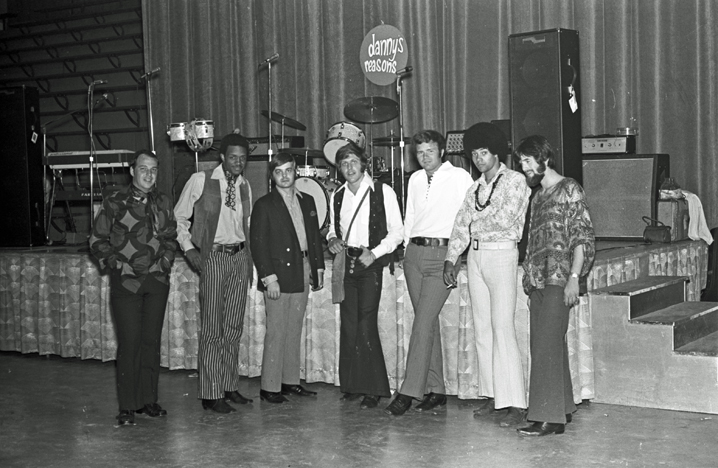
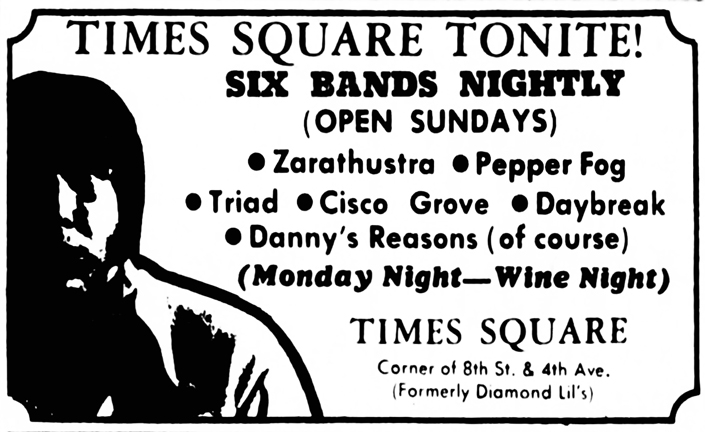
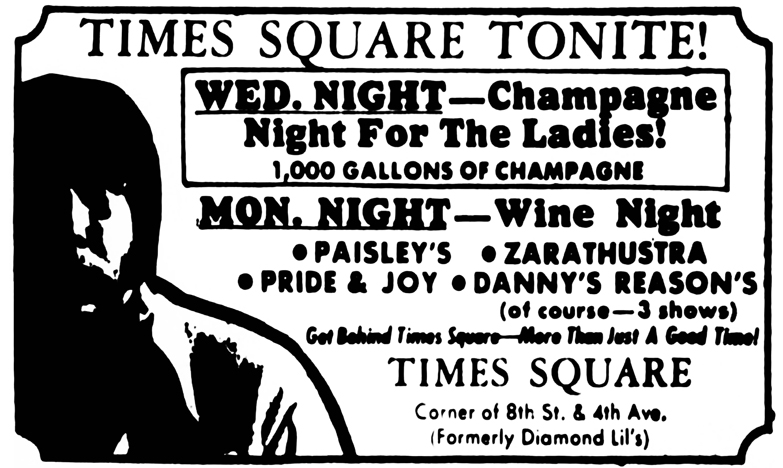
Times Square lasted until about February of 1970.
FRIAR’S DINNER THEATER
An article dated January 4, 1970, indicated that the building had been leased by Stuart Schwartz and Bill Roslansky. In turn, they entered into an agreement with Dick Shapiro and Bill Semans to turn the place into the Friars, a theater-nightclub-restaurant, not to be confused with a dinner theater. Their plan was to bring in off-Broadway shows. The first show, “The Boys in the Band,” was scheduled to open on February 3, 1970. (Minneapolis Tribune, January 4, 1970) It turned out that this plan never came to pass. (Tribune, February 8, 1970)
On March 18, 1970, the upstairs became the Friar’s Dinner Theater, run by Bill Roslansky and Stuart Schwartz. The first production was Neil Simon’s “Come Blow Your Horn,” produced and directed by Stockton Briggle.
In July 1971, owners Bill Roslansky and Stewart Swartz sold the Friars Dinner Theater to the Hotel Hastings, owned by Jack Dow. (Minneapolis Star, July 29, 1971)
Jeff Lonto sent the image below, saying “This came from a magazine called Today In The Twin Cities, September 8-14, 1973. It was published by TV Times and had a TV listing section plus ads and listings for restaurants and night clubs, and was apparently given away in motel lobbies. The “fabulous fifties” guy in this ad looks more like he’s smack dab out of September 1973.”
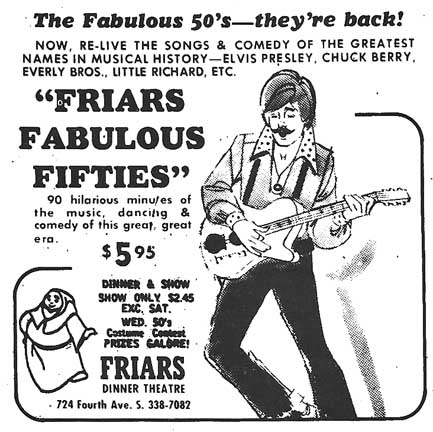
FRIARS MINNESOTA MUSIC HALL DINNER THEATER
On January 29, 1974, it became the Friars Minnesota Music Hall Dinner Theater, Ray Carlson, Manager. It had a capacity of 500. It closed in March 1975.
Chimera West: Jim Borland, August 21 to December 13, 1975.
Betty Jo Byoloski’s: February 15 to December 1, 1975. Apparently all of the wait staff were in costume and none had any serving experience.
Off Night Music Hall at the Downtown Dinner Theater: Opened Fall 1976 to about March 1977
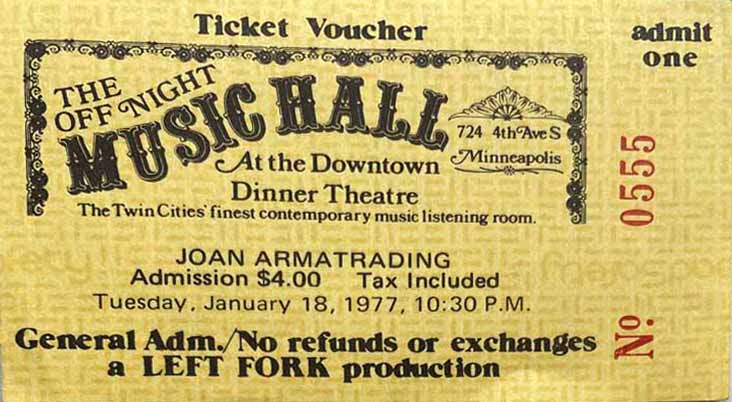
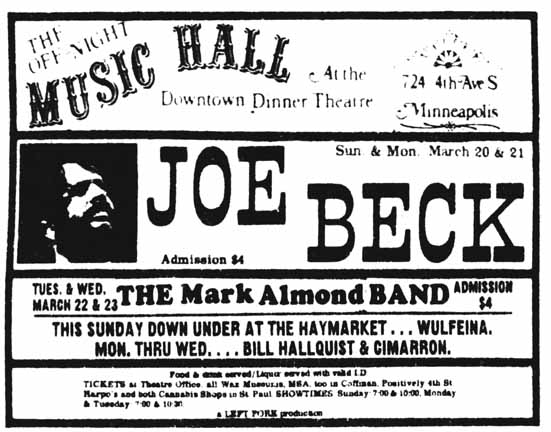
CENTRAL PARK
Central Park Disco was run by Lee Swearington, from December 1975 to January 1977.
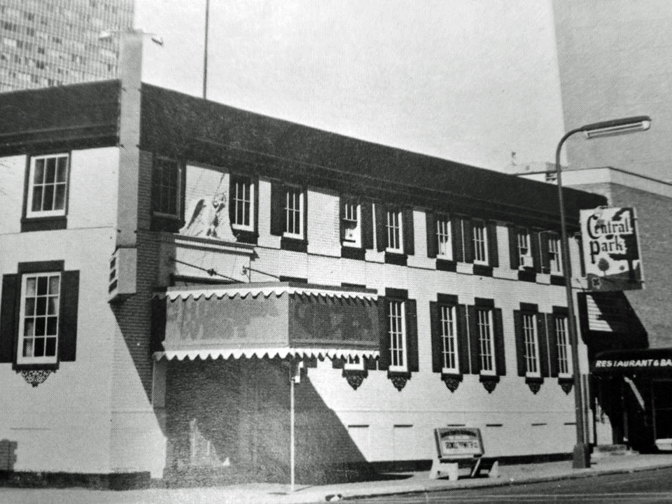
Down Under at the Haymarket: 1977
Jack Dow lost the building in bankruptcy in April 1977.
Herald’s Christian Supper Club opened on December 31, 1977. It moved downstairs in August 1978.
Music Box: Dale Olson was the owner/manager in August 1978.
Discotrec II, a Teen Disco patterned after a similar operation in Eagan, opened upstairs in January 1979. Herald’s had moved downstairs for lack of business.
DOWNSTAIRS
LITTLE AL’S
In 1967, Dave Rooney moved into the downstairs of Diamond Lil’s and called the new place Little Al’s.
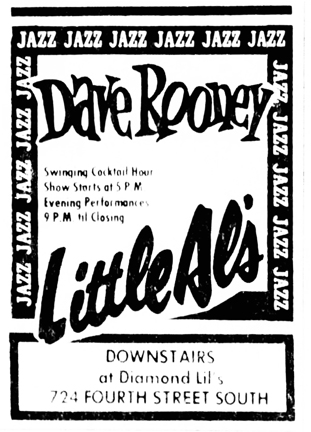
Rooney moved out of the building in December 1969 in the face of dropping profits. His new digs were the basement below the Roaring Twenties.
DAVE ROONEY LOUNGE
By May 24, 1970, Rooney was back, and the downstairs had become the Dave Rooney Lounge.
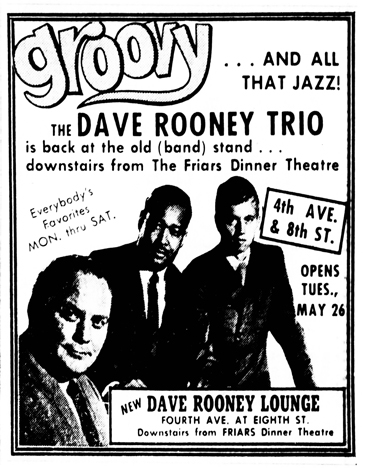
FRIAR’S CABARET
By about March 1972, however, the downstairs had become the Friar’s Cabaret, again frustrating attempts to keep jazz alive in the Twin Cities.
In October 1972, Strib columnist Irv Letovsky reported that a recent policy to bring in name acts to the downstairs cabaret wasn’t doing so well – a show in September with Rudy Vallee only brought in 66 paying customers.
The Music Preserve opened on June 7, 1977, replacing the Friar’s Cabaret.
In August 1978, Herald’s Christian Supper Club moved downstairs.
Perhaps after determining that the building was cursed, it was mercifully demolished in August/September 1981. The site is now the 33-floor SPS Tower, built in 1987. The address changed to 333 7th Street South.
